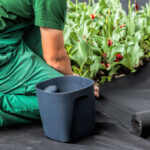Introduction
Landscape fabric is a special material used in gardens and landscaping to prevent weeds from growing. It’s like a barrier that sits under the soil and stops unwanted plants from popping up, making it easier to keep your garden neat and tidy. Landscape fabric also helps the soil stay moist longer because it reduces the water that evaporates from the soil.
Using landscape fabric has several benefits. It saves you time because you won’t need to weed your garden as often. This fabric also helps your desired plants grow better because they don’t have to compete with weeds for nutrients and water. Plus, it can make your garden look cleaner and more organized. For anyone who loves gardening but doesn’t like the hassle of constant weeding, landscape fabric can be a great help.
Types of Landscape Fabric
Landscape fabric comes in several different types, each made from different materials and designed for different uses in your garden. Let’s discuss the three main types: woven, and non-woven fabrics.
Woven Landscape Fabric
Woven landscape fabric is a versatile and essential tool for commercial landscaping projects. It is designed to suppress weeds while allowing water and nutrients to penetrate the soil, making it an ideal choice for tree and shrub plantings. Its durability makes it highly effective for erosion control, stabilizing soil in areas prone to degradation. Woven landscape fabric is a sustainable choice that offers long-term benefits, improving the health and appearance of landscaped areas while reducing maintenance needs.
Uses and Applications
- Agriculture Field: For agriculture fields, woven landscape fabric proves invaluable in large-scale farming operations. It enhances crop yield by suppressing weeds, which compete with crops for nutrients, water, and light. By acting as a barrier to sunlight, it prevents weed germination, significantly reducing the labor and cost associated with manual or chemical weed control methods.
- Tree and Shrub Plantings: For tree and shrub plantings, woven fabric provides excellent soil stabilization, helping young plants establish their roots without competition from weeds. The fabric can be cut to fit around the base of trees and shrubs, ensuring that they receive adequate nutrients and water while keeping the surrounding area weed-free.
- Erosion Control: Woven landscape fabric is highly effective in erosion control applications. Its strength helps to stabilize the soil on slopes and in areas prone to erosion, preventing soil displacement caused by wind or water. This makes it a valuable tool in landscaping projects aimed at preserving soil integrity and preventing land degradation.
Key Benefits
- Durability: Its strong, woven construction resists tearing and damage, making it suitable for high-traffic and heavy-use areas.
- Weed Control: The fabric effectively blocks weed growth, reducing the need for herbicides and manual weeding.
- Soil Stabilization: Ideal for erosion control, the fabric helps maintain soil structure and prevent erosion.
- Versatility: Suitable for various applications, from garden beds to erosion control, providing a reliable solution for multiple landscaping needs.
Non-Woven Landscape Fabric
Non-woven landscape fabric is more like felt. It’s made by pressing fibers together. This type is best for flower beds or areas where you want to grow plants because it lets water and air move through it better than woven fabric. The downside is that it’s not as strong as woven fabric, so it might not work well under heavy materials like large rocks.
Choosing the right type of landscape fabric depends on what you need for your garden. Woven fabric is stronger but doesn’t let much water through, non-woven fabric is softer and good for plants.
Preparation Before Installation
Preparing the area properly before you lay down landscape fabric is important. This will help you get the best results and make your garden look great.
Clearing the Area
First, you need to clear where you want to put the fabric. Remove all the weeds, old plants, and debris like sticks and leaves. Make sure the soil is smooth and flat. If there are any big clumps of dirt or rocks, break them up or remove them. This makes it easier for the fabric to lie flat and work properly.
Preparing the Soil
Once the area is clear, getting the soil ready is a good idea. Even though the fabric will cover the soil, you still want it to be healthy for your plants. Add some compost or soil amendments to give your plants a good start. Mix these into the top few inches of the soil. This step helps improve the soil’s health, making it better for plants to grow strong roots.
After you’ve prepared the soil, you can lay the landscape fabric down. This preparation ensures the fabric works well and your garden stays beautiful and healthy.
Installation Process
Installing landscape fabric is a straightforward process that can significantly benefit your garden. Here’s a simple step-by-step guide on how to do it, along with some tips on cutting and securing the fabric:
Step-by-Step Installation Guide
- Lay the Fabric: Roll out the landscape fabric over your prepared area. Make sure it covers the entire area and is flat against the soil. You must use multiple pieces if your area is wider than the fabric roll.
- Cutting the Fabric: Use scissors or a utility knife to cut the fabric to the right size. Let’s leave extra fabric on the edges to ensure the entire area is covered.
- Secure the Fabric: Use landscape staples or fabric pegs to secure the fabric to the ground. Place these about every 2 feet along the edges of the fabric and anywhere the fabric overlaps.
- Handling Overlaps: When using more than one piece of fabric, ensure the edges overlap by at least 6 inches. This overlap helps prevent weeds from finding their way through the gaps.
- Trimming Edges: Trim the fabric so it fits nicely at the edges of your garden beds or walkways. Tuck any excess fabric into the soil to keep it neat and secure.
Tips for Effective Installation
- Always lay the fabric smooth and flat; avoid any wrinkles or bunching, as this can create spaces for growing weeds.
- When cutting holes for plants, make a small X rather than a large hole to keep as much soil covered as possible.
- Check the fabric regularly, pin down any lifted areas, or resecure any loose pegs to maintain effectiveness.
By following these steps, you’ll ensure that your landscape fabric is installed correctly, helping to keep your garden weed-free and tidy.
Maintenance Tips
Maintaining landscape fabric is key to ensuring it works effectively for a long time. Here’s how you can take care of it and handle common issues that might pop up:
Maintaining the Fabric for Longevity
- Regular Checks: Every few months, walk around your garden and check the landscape fabric. Look for areas where it might lift up or where mulch has moved away, exposing the fabric.
- Keep It Covered: To protect the fabric and extend its life, keep it covered with mulch or gravel. This cover keeps the fabric hidden, helps hold it down, and prevents damage from the sun’s UV rays.
- Add More Mulch: Mulch can decompose or get blown away over time. Every year, add a new layer of mulch to keep the fabric well-covered and continue suppressing weeds.
Dealing with Common Issues
- Fixing Tears: If you find a tear in the fabric, clean the area around it and patch it with a piece of landscape fabric or a special fabric repair tape. Secure the patch with landscape staples to keep it in place.
- Weeds Poking Through: Sometimes, weeds might find their way through small holes or tears in the fabric. Pull these weeds as soon as you see them and check if the fabric needs a patch or extra staples around that area.
- Handling Fabric Exposure: If fabric parts are exposed due to wind or erosion, re-cover them with mulch or soil. If the fabric has become loose, secure it again with more staples or pegs to keep it flat against the ground.
By following these maintenance tips, you can ensure that your landscape fabric remains effective and helps keep your garden neat and weed-free for years.
In conclusion, properly installing and maintaining landscape fabric is crucial for its effectiveness in weed control and soil health management. Whether you choose Anita Plastics high-quality woven landscape fabric, consider your specific garden needs and the level of maintenance you’re prepared to commit to. If landscape fabric fits your project, ensure it’s installed correctly and maintained regularly for the best results.
Consulting with a professional can ensure that everything goes smoothly for those planning large or complex landscaping projects. Remember, Anita Plastics is a trusted manufacturer of woven landscape fabric, ready to support your gardening and landscaping endeavors.




